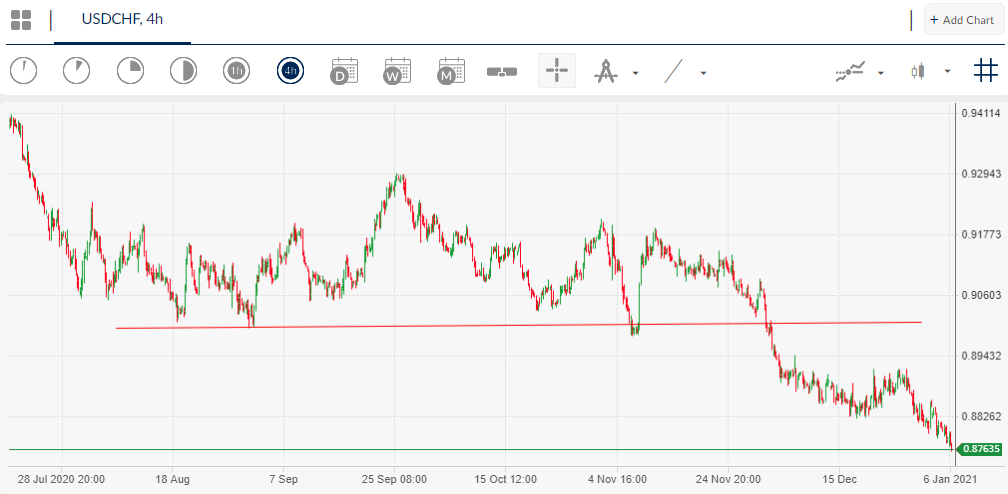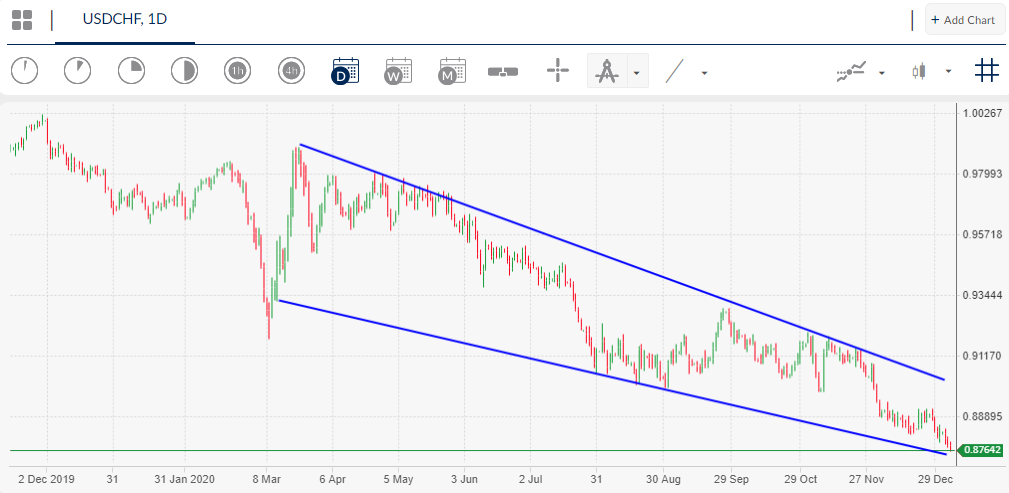The US dollar is coming back under pressure on the foreign exchange market on Wednesday against the Swiss franc currency, as the multi-month downtrend in the risk-sensitive pair shows few signs of abating.
Traders typically move into safe-haven currencies such as the Japanese yen and Swiss franc during times of uncertainty. The Georgia run-off is a political risk event, hence why the USDJPY and USDCHF pairs are coming under renewed pressure this week.
In terms of the US dollar equation, things look particularly bearish for the greenback at the moment. The US dollar index is trading at levels not seen since April 2018 and could sink further if a blue wave takes place in US Senate, as it currently predicted.
Even the recent December ISM report failed to lift the US dollar from the doldrums. The December ISM report was the strongest of 2020, and was also 8.2% above the 2020 average, of 52.5%.
Another consideration with the USDCHF pair is the fact that the pair has an almost mirror type relationship with the EURUSD. Often, when the EURUSD pair is rising the USDCHF pair will be falling.
With the EURUSD pair breaking the 1.2300 level, the technicals for the USDCHF pair will almost certainly worsen if we see the EURUSD past advancing towards the 1.2400 and 1.2500 resistance zones.
From a technical perspective, the USDCHF pair is heavily bearish after convincingly breaking below the May 2015 trading low last month. The USDCHF has space technical support until the 0.8700 and 0.8200 levels now that the 0.9000 handle is breached.
USDCHF Short-Term Technical Analysis
The four-hour time frame continues to highlight the bearish pressure that the USDCHF pair is in at the moment. Technical analysis highlights that a bearish head and shoulders pattern was activated last month, following a break under the 0.8990 level.
According to the overall size of the head and shoulders pattern the USDCHF pair could be headed towards the 0.8700 support level over the short-term horizon.


Source by ActivTrader
It remains to be seen if the USDCHF pair can bounce from the 0.8700 support level once the head and shoulders pattern plays out towards its full downside target on the mentioned time frame.
However, if you are bullish towards the USDCHF pair then looking for weakness in the prevailing trend around the 0.8700 area may be a good swing strategy, in expectation of a recovery to at least the 0.8900 or 0.8990 areas.
USDCHF Medium-Term Technical Analysis
Looking at the daily time chart a falling wedge pattern can clearly be seen, with the USDCHF pair currently testing towards the bottom of the wedge, around the 0.8740 level.
Typically, falling wedge patterns are considered to be amongst the most powerful bullish reversal patterns. Traders usually look to buy around the bottom of wedge or await breakout above the top of the wedge pattern.


Source by ActivTrader.
The daily time frame currently shows that bulls need to break above the 0.8980 level in order to stage an upside breakout. Technical analysis highlights the 0.9300 level as a possible upside target if a bullish wedge break occurs.
Traders should note that the RSI indicator on the daily time frame is showing that the USDCHF pair is not yet oversold and has further scope to weaken.



